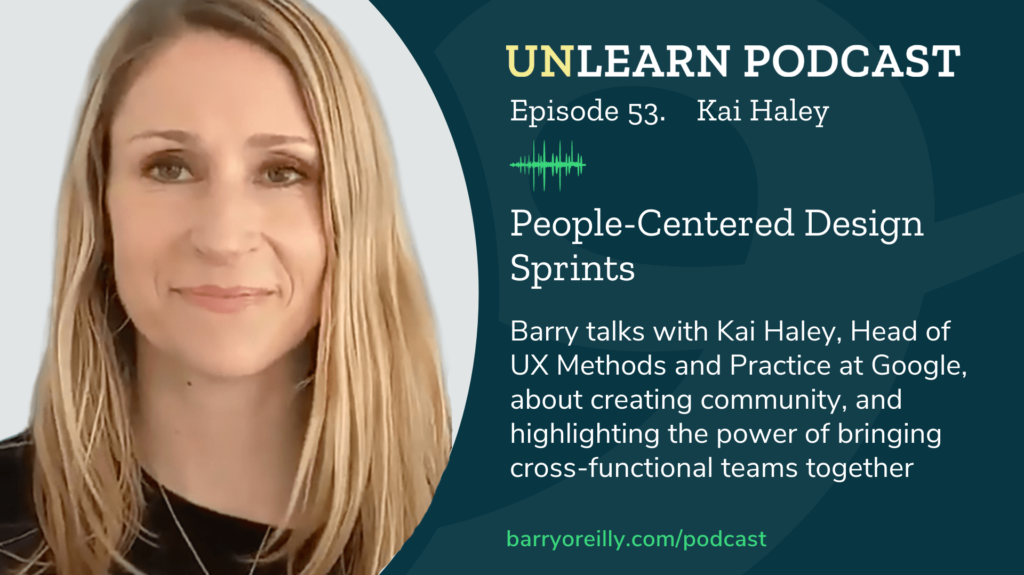Kai Haley is the Head of UX Methods and Practice at Google and the founder and leader of the Google Sprint Leadership Academy. She is an expert at leading change, creating movements and creating high performance teams. Barry O’Reilly says of her, “She was one of the first people to embrace design sprints at Google and helped formulate that practice, codify it, and has coached hundreds – if not thousands – of people how to use these tools to identify product visions, drive successful user-centered products, and build cultures of innovation all across Google and outside.” She joins Barry in this week’s show to talk about how design sprints started, lessons she unlearned along the way, and the importance of designing for people first. Listen to this podcast to discover the importance of people-centered design sprints.
Looking Outside
Look for patterns and inspiration outside of your field, Kai advises. “I do gravitate towards looking outside of wherever I’m focused right now to how are people solving things over here, or what inspiration could we gain from something else?” she says. Her undergraduate study in anthropology helps her to keep the human and cultural connection top of mind in any design project. “When I’m looking outside of the discipline of design I’m keeping my eyes on the people and who this is for and who are we trying to solve these problems for,” she tells Barry. [Listen from 2:15]

Origin of Design Sprints
Creating a high performance cross-functional team requires a shared language and a shared idea of success. Getting design sprints off the ground meant that Kai and her team needed to bring together elements of design thinking, user research, business methods and psychology. The term ‘sprint’ was used to get the engineering team to buy in, as they were already used to ‘agile sprints’. Kai tells Barry that the first sprints were just four hours long, while other people were running longer sessions. Starting small gained her buy-in as everyone praised how impactful the exercise was, and asked for more. Her manager soon asked her to have one every two weeks. “In a very small and quick way I was able to get what we needed as a team, which was shared vocabulary, shared understanding of success, ideation, and then we could choose a direction together and then send people off to start executing against it,” she comments. [Listen from 7:30]
Key Lessons
Barry asks Kai to share the key lessons from her design sprint journey. She explains that every design sprint would be different, so when she trains people she doesn’t use a rigid framework. Instead she wants them to focus on the goal to accomplish; she wants them to use the tools she teaches and modify them for their unique circumstances. “How are you going to get alignment and buy in before you even get people into the room? And then once you get them into the room, how do you make sure you don’t waste their time?” she asks leaders to consider. [Listen from 13:25]
She and Barry discuss other key lessons, including:
It takes attention and focus to help people learn how to learn. [17:25]
Nurture a culture that encourages people to try things. [19:30]
Think about the humans you are designing for. Kai advocates for an inclusive co-creation approach. [20:50]
“Movements are really important because they give people something to believe in.” [21:15]
Share a common vision and metric of success. [22:00]
Start where you can show the impact. [22:15]
Focus on the people who want to change. [23:50]
Looking Ahead
Kai believes that humans will continue to be at the heart of design sprints in the future. Technology affords us the ability to communicate and collaborate in new ways, “but we still need to bring the people with us,” she says. We need to improve how we communicate using the technology, especially since we will be spending less time together in a physical space. She and Barry agree that we will have to focus on making the limited time we have together measurably impactful. However, Kai advises, that doesn’t necessarily mean doing more. “I think part of what we need to do is slow down a little bit and be thoughtful,” she remarks. “Make those moments meaningful, and where does meaning come from? It comes from human connection and understanding each other.” [Listen from 25:20]
Don’t want to miss a post? Sign up for my podcast newsletter and monthly newsletter!















